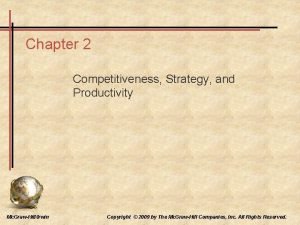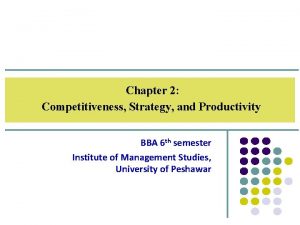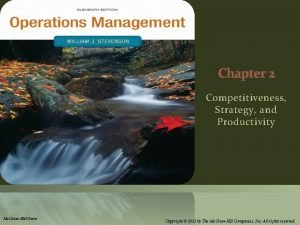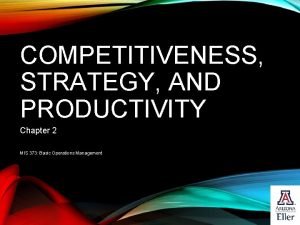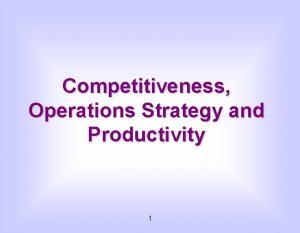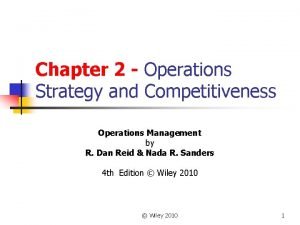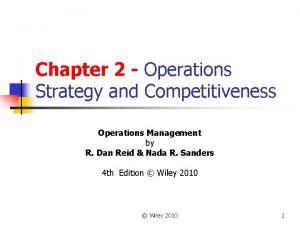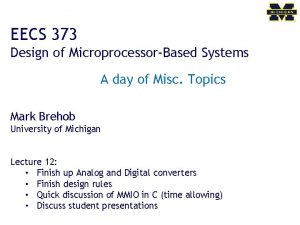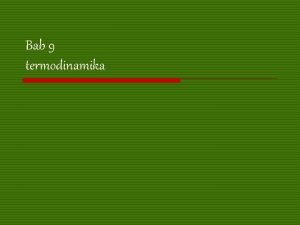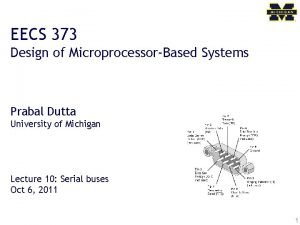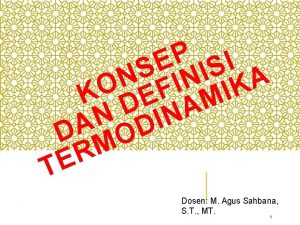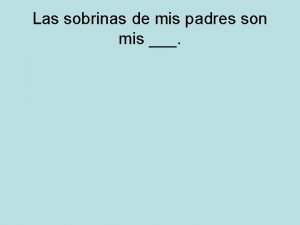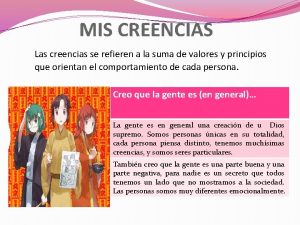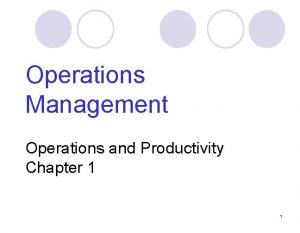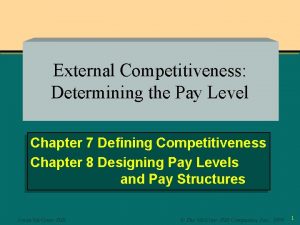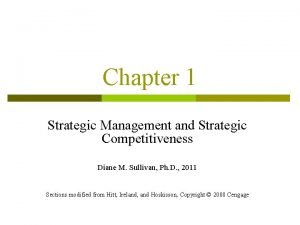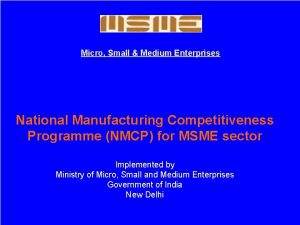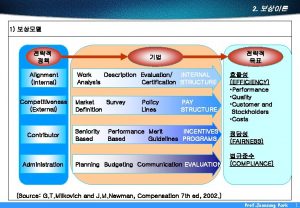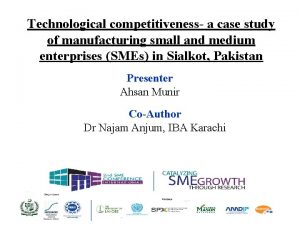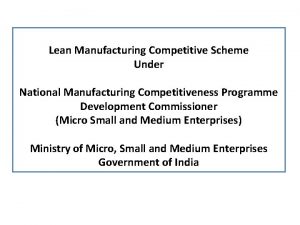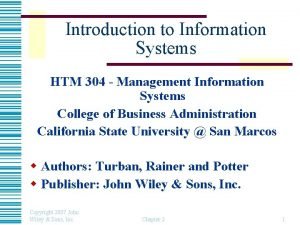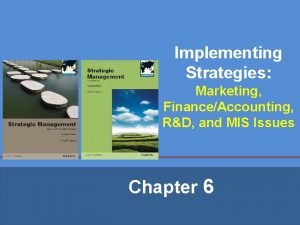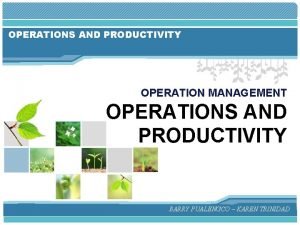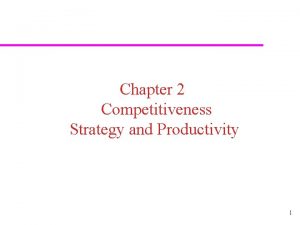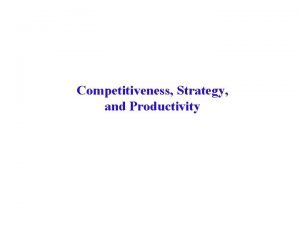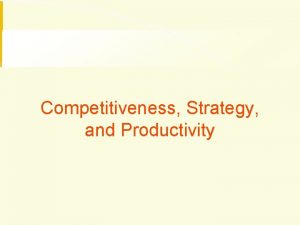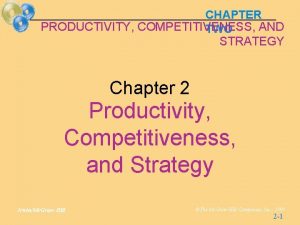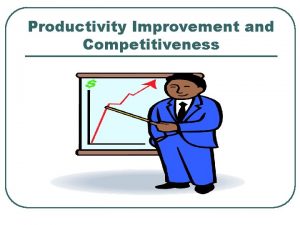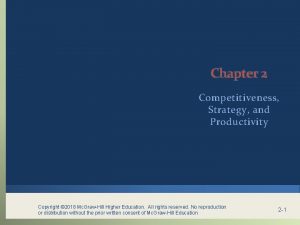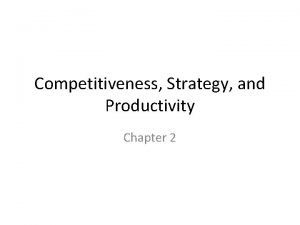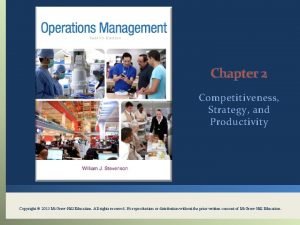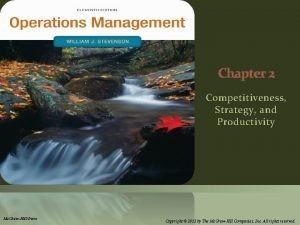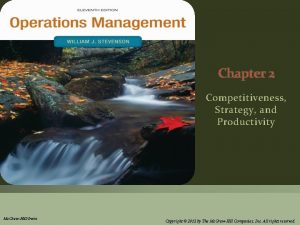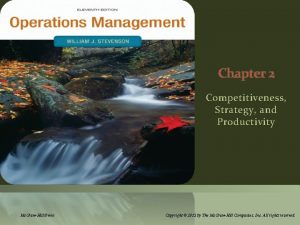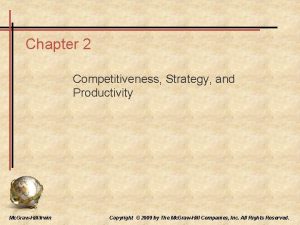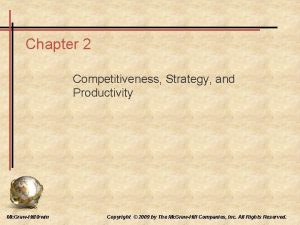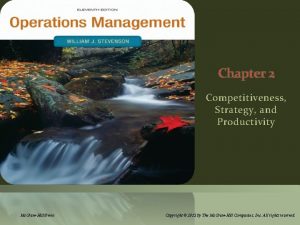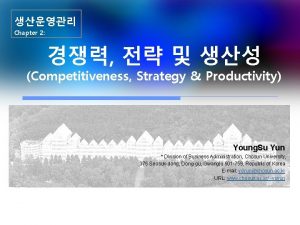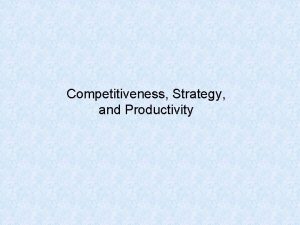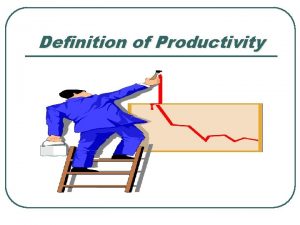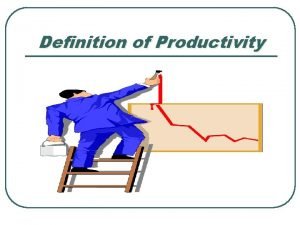COMPETITIVENESS STRATEGY AND PRODUCTIVITY Chapter 2 MIS 373











































- Slides: 43

COMPETITIVENESS, STRATEGY, AND PRODUCTIVITY Chapter 2 MIS 373: Basic Operations Management

LEARNING OBJECTIVES • After this lecture, students will be able to 1. List several ways that business organizations compete. 2. Discuss and compare organization strategy and operations strategy and explain why it is important to link the two. 3. Define the term productivity and explain why it is important to organizations and to countries. 4. Describe several factors that affect productivity. MIS 373: Basic Operations Management 2

OVERVIEW • Three separate, but related concepts that are vitally important to business organizations: • Competitiveness • Strategy • Productivity MIS 373: Basic Operations Management 3

COMPETITIVENESS • Competitiveness: • How effectively an organization meets the needs of customers relative to others that offer similar goods or services • Organizations compete over: • • Price (Cost): WAL-MART Quality: BMW Response-time: UPS Variety (Flexibility): DELL MIS 373: Basic Operations Management 4

OPERATIONS’ INFLUENCE ON COMPETITIVENESS • • • Product and service design Cost Location Quality Quick response Flexibility Inventory management Supply chain management Service Managers and workers MIS 373: Basic Operations Management Competitiveness 5

WHY SOME ORGANIZATIONS FAIL • Neglecting operations strategy. • Failing to take advantage of strengths and opportunities, and/or failing to recognize competitive threats. • Putting too much emphasis on short-term financial performance at the expense of research and development. • Placing too much emphasis on product and service design and not enough on process design and improvement. • Neglecting investments in capital and human resources. • Failing to establish good internal communications and cooperation among different functional areas. • Failing to consider customer needs. MIS 373: Basic Operations Management 6

EXERCISE • Name 10 ways that banks compete for customers. • Hint: consider operations’ influence on competitiveness • • • Product and service design Cost Location Quality Quick response Flexibility Inventory management Supply chain management Service Managers and workers

HIERARCHICAL PLANNING AND DECISION MAKING Mission Goals Organizational Strategies Functional Goals Finance Strategies Tactics Operating procedures MIS 373: Basic Operations Management Marketing Strategies Tactics Operating procedures Operations Strategies Tactics Operating procedures 8

WAL-MART DELIVERY SERVICE SAYS TO AMAZON: 'BRING IT' • wsj. com 10/19/2012 • In its latest bid to take on … Amazon. com this holiday season, Wal-Mart is promising same-day delivery in some cities for orders placed online. Called Wal-Mart To Go, the service costs $10 regardless of the size of the order. • The products will be shipped from the company's stores, not from a warehouse or distribution center. … Wal-Mart is betting that its network of thousands of stores, combined with an improved online presence … can help it compete head to head with Amazon, which has increasingly stressed fast, free or low-cost deliveries. • UPS will pick up the goods and deliver them to customers • Nearly half of Wal-Mart's online sales now come from purchases customers make online and pick up at a store, … "We have a unique advantage because we have the national footprint of stores combined with our online site that enable programs like site to store, pay with cash or pick up today, …" MIS 373: Basic Operations Management 9

HIERARCHICAL PLANNING AND DECISION MAKING Mission Goals Organizational Strategies “Wal-Mart To Go” Functional Goals Finance Strategies Tactics Operating procedures MIS 373: Basic Operations Management Marketing Strategies Tactics Operating procedures Operations Strategies Tactics Operating procedures 10

MISSION AND GOALS • Mission • The reason for an organization’s existence • Mission statement • States the purpose of the organization • The mission statement should answer the question of “What business are we in? ” • The mission statement serves as the basis for organizational goals • Goals • Provide detail and the scope of the mission • Goals can be viewed as organizational destinations • Goals serve as the basis for organizational strategies MIS 373: Basic Operations Management 11

EXAMPLE MISSION STATEMENTS • Fed. Ex Mission Statement • http: //about. van. fedex. com/mission-strategy-values • Fed. Ex Corporation will produce superior financial returns for its shareowners by providing high value-added logistics, transportation and related business services through focused operating companies. Customer requirements will be met in the highest quality manner appropriate to each market segment served. Fed. Ex will strive to develop mutually rewarding relationships with its employees, partners and suppliers. Safety will be the first consideration in all operations. Corporate activities will be conducted to the highest ethical and professional standards. MIS 373: Basic Operations Management 12

STRATEGY • Strategy • A plan for achieving organizational goals • Serves as a roadmap for reaching the organizational destinations • Organizations have • Organizational strategies • Overall strategies that relate to the entire organization • Support the achievement of organizational goals and mission • Functional level strategies • Strategies that relate to each of the functional areas and that support achievement of the organizational strategy MIS 373: Basic Operations Management 13

TACTICS AND OPERATIONS • Tactics • The methods and actions taken to accomplish strategies • The “how to” part of the process • Operations • The actual “doing” part of the process MIS 373: Basic Operations Management 14

ORGANIZATIONAL STRATEGY • Low Price • Outsource operations to countries with low labor cost • Use capital-intensive methods to achieve high output volume and low unit cost • Specialization • Focus on narrow product lines or limited services to achieve higher quality • Responsiveness (time-based strategies) • Strategies that focus on the reduction of time needed to accomplish tasks • Differentiation: Variety • Focus on customization • Differentiation: Newness • Focus on innovation to create new products or services • Differentiation: Service • Focus on various aspects of service (e. g. , helpful, reliable, etc) • Differentiation: Quality • focus on quality in all phases of an organization in order to achieve higher quality than competitors MIS 373: Basic Operations Management 15

OPERATIONS STRATEGY • The organizational strategy provides the overall direction for the organization. It is broad in scope, covering the entire organization. • Operations strategy is narrower in scope, dealing primarily with the operations aspect of the organization. Operations strategy relates to products, processes, methods, operating resources, quality, costs, lead times, and scheduling. • In order for operations strategy to be truly effective, it is important to link it to organization strategy MIS 373: Basic Operations Management 16

EXAMPLES OF STRATEGIES Organizational Strategy Low Price Responsiveness Differentiation: High Quality Differentiation: Newness Differentiation: Variety Differentiation: Service Differentiation: Location Operations Strategy Low Cost Short processing times On-time delivery High performance design and/or high quality processing Consistent Quality Innovation Flexibility Volume Superior customer service Convenience MIS 373: Basic Operations Management Examples of Companies or Services Wal-Mart Southwest Airlines Mc. Donald’s restaurants Fed. Ex BMW Coca-Cola 3 M Apple Burger King (“Have it your way”) Mc. Donald’s (“Buses Welcome”) Disneyland IBM Supermarkets Banks, ATMs 17

3 M • Founded in 1902, 3 M started out in the mining business as the Minnesota Mining and Manufacturing Company. • 3 M launched the 15 percent program in 1948. • a program at 3 M that allows employees to use a portion of their paid time to chase rainbows and hatch their own ideas. • Thirty Percent Rule, 30% of each division’s revenues must come from products introduced in the last four years. • Over a 20 -year period, 3 M’s gross margin averaged 51% and the company’s return on assets averaged 29%. • Mission • 3 M is a science and technology company that creates. For decades, 3 M scientists and engineers have developed products that solve problems. 3 M is also a company that cares – improving lives each day. The mission of 3 Mgives: To Improve Every Life through Innovative Giving in Education, Community and the Environment – mirroring our corporate vision: • 3 M Technology Advancing Every Company • 3 M Products Enhancing Every Home • 3 M Innovation Improving Every Life

EXERCISE • Name three companies that are not in the examples I gave, and describe their core organizational strategies in terms of the following options: • • Low Price Specialization Responsiveness Differentiation: Quality Differentiation: Newness Differentiation: Variety Differentiation: Service Wal-Mart Southwest Airlines Mc. Donald’s Fed. Ex BMW Coca-Cola 3 M Apple Burger King Disneyland IBM Supermarkets Banks, ATMs • Go online and find the mission statements of the three companies. Are their strategies aligned with their mission statements?

STRATEGY FORMULATION • Three common approaches • Michael Porter's five forces model • Environmental scanning (SWOT) • Balanced Scorecard MIS 373: Basic Operations Management 20

PORTER'S FIVE FORCES MODEL Source: http: //www. quickmba. com/strategy/port er. shtml SUPPLIER POWER Supplier concentration Importance of volume to supplier Differentiation of inputs Impact of inputs on cost or differentiation Switching costs of firms in the industry Presence of substitute inputs Threat of forward integration Cost relative to total purchases in industry THREAT OF NEW ENTRANTS DEGREE OF RIVALRY THREAT OF SUBSTITUTES Barriers to Entry Absolute cost advantages Proprietary learning curve Access to inputs Government policy Economies of scale Capital requirements Brand identity Switching costs Access to distribution Exit barriers Industry concentration Fixed costs/Value added Industry growth Intermittent overcapacity Product differences Switching costs Brand identity Diversity of rivals Corporate stakes Switching costs Buyer inclination to substitute Price-performance trade-off of substitutes BUYER POWER MIS 373: Basic Operations Management Bargaining leverage Buyer volume Buyer information Brand identity Price sensitivity Product differentiation Substitutes available Buyers' incentives 21

PORTER ON HIS FIVE FORCES MODEL

SWOT • Environmental scanning (SWOT) • Internal Factors • Strengths and Weaknesses • External Factors • Opportunities and Threats MIS 373: Basic Operations Management 23

1. Human Resources • SWOT: KEY INTERNAL FACTORS Skills of workforce, expertise, experience, loyalty to the organization 2. Facilities and equipment • Capacities, locations, age, maintenance costs 3. Financial resources • Cash flow, access to additional funding, debt, cost of capital 4. Customers • Loyalty, wants and needs 5. Products and services • Existing, potential for new ones 6. Technology • Existing, ability to integrate new and its impact on current and future operations 7. Suppliers • Relationships, dependency, quality, flexibility, service 8. Other • Labor relations, company image, distribution channels etc. MIS 373: Basic Operations Management 24

SWOT: KEY EXTERNAL FACTORS 1. Economic conditions • Health and directions of the economy, inflation, deflation, interest rates, taxes, tariffs. 2. Political conditions • Attitude towards business, political stability, wars 3. Legal environment • Antitrust laws, regulations, trade restrictions, minimum wages laws, liability laws, labor laws, patents 4. Technology • Innovations rate, future process technology, design technology 5. Competition • Number and strength of competitors, basis of competitions (price, quality etc. ) 6. Markets • Size, location, brand loyalty, ease of entry, growth potential, long term stability, demographics. MIS 373: Basic Operations Management 25

BALANCED SCORECARD • The idea of Balanced Scorecard (BSC) is to move away from a purely financial perspective of the organization and integrate other perspectives such as customers, internal business processes, and learning and growth. Lag Balanced • Financial • How should we appear to our shareholders? • Consumer • How should we appear to our customers? • Internal Business Process Scorecard Objective measure Measure Target Improve consumer Survey Up 20% satisfaction and score loyalty by 20% Delivery < 4 days time • What business process must we excel at? • Learning & Growth • How will we sustain our ability to change/improve? MIS 373: Basic Operations Management Leading measure 26

BALANCED SCORECARD MIS 373: Basic Operations Management 27

STEPS IN STRATEGY FORMULATION 1. Link strategy directly to the organization's mission or vision statement. 2. Assess strengths, weaknesses, threats and opportunities, and identify core competencies. • Core competencies: The special attributes or abilities that give an organization a competitive edge 3. Identify order winners and order qualifiers. • Order winners: Characteristics of an organization’s goods or services that cause it to be perceived as better than the competition • Order qualifiers: Characteristics that customers perceive as minimum standards of acceptability for a product or service to be considered as a potential for purchase 4. Select one or two strategies (e. g. , low cost, speed, customer service) to focus on. MIS 373: Basic Operations Management 28

PRODUCTIVITY • Productivity • A measure of the effective use of resources, usually expressed as the ratio of output to input Outputs Productivity = Inputs • Productivity measures are useful for • Tracking an operating unit’s performance over time • Judging the performance of an entire industry or country MIS 373: Basic Operations Management 29

• wsj. com 1/12/2012 • “The Factory Floor Has a Ceiling on Job Creation ” • Factories have been producing more with fewer workers. • Output for each hour of work, or productivity, is up an extraordinary 40% as factories have adopted new technologies and production processes.

WHY DOES PRODUCTIVITY MATTERS? Brynjolfsson, E. , and Hitt, L. M. 1998. Beyond the productivity paradox. Communications of the ACM 41(8) 49– 55. • Productivity growth determines our living standards and the wealth of nations. This is because the amount a nation can consume is ultimately closely tied to what it produces. • By the same token, the success of a business generally depends on its ability to deliver more real value for consumers without using more labor, capital, or other inputs. MIS 373: Basic Operations Management 31

MEASURES OF PRODUCTIVITY Outputs Productivity = Inputs Partial measures Multifactor measures Total measure Output Labor Output Machine Capital Output Labor + Machine Output Energy Output Labor + Capital + Energy Goods or Services Produced All inputs used to produce them MIS 373: Basic Operations Management 32

EXAMPLES OF PARTIAL PRODUCTIVITY MEASURES Partial Productivity Measures Examples Labor Productivity Units of output per labor hour Units of output per shift Value-added per labor hour Machine Productivity Units of output per machine hour Capital Productivity Units of output per dollar input Dollar value of output per dollar input Energy Productivity Units of output per kilowatt-hour Dollar value of output per kilowatt-hour MIS 373: Basic Operations Management 33

EXERCISE Units produced: 5, 000 Standard price: $30/unit Labor input: 500 hours Cost of labor: $25/hour Cost of materials: $5, 000 Cost of overhead: 2 x labor cost Hint: The key of this calculation is to convert all the elements to their dollar values. What’s the dollar value of the output / labor / material / overhead? What is the implication of an unitless measure of productivity?

PRODUCTIVITY GROWTH Current productivity − Pervious productivity Productivity Growth = × 100% Pervious productivity • Example: Labor productivity on the ABC assembly line was 25 units per hour in 2009. In 2010, labor productivity was 23 units per hour. What was the productivity growth from 2009 to 2010? Productivity Growth = MIS 373: Basic Operations Management 23 − 25 25 × 100% = − 8% 35

SERVICE SECTOR PRODUCTIVITY �Service sector productivity is difficult to measure and manage because �It involves intellectual activities �It has a high degree of variability �Measurement Difficulties �Retailors �Quality Versus Quantity �Nurses MIS 373: Basic Operations Management 36

HEALTH CARE PRODUCTIVITY • Kocher, Robert, and Nikhil R. Sahni. "Rethinking health care labor. " New England Journal of Medicine 365. 15 (2011): 1370 -1372. • Of the $2. 6 trillion spent in 2010 on health care in the United States, 56% consisted of wages for health care workers. • the “output” is the volume of activity — including all encounters, tests, treatments, and surgeries — per unit of cost

HEALTH CARE PRODUCTIVITY • IBM Healthcare Industry: 2020 Vision • adoption of new practices • drug effectiveness evaluation • risk prediction & prevention • reduce tests and costs • personalized medicine • patient education & empowerment

FACTORS AFFECTING PRODUCTIVITY Methods Capital INCREASE: Calculators, Computers, Faxes, copiers, Internet search engines, Voice mail, cell phones, email Quality Technology MIS 373: Basic Operations Management REDUCE: inflexibility, high costs, mismatched operations, non-work activities 39

PRODUCTIVITY & TECHNOLOGY • NPR 4/30/13 When It Comes To Productivity, Technology Can Hurt And Help • With instant messages buzzing, emails pinging and texts ringing, how can employers increase productivity in the workplace? Software companies are tackling the problem, tracking employees' computer time to find ways to improve their efficiency. • Desk workers, creative workers, …

PRODUCTIVITY PARADOX • Brynjolfsson, E. , and Hitt, L. M. 1998. Beyond the productivity paradox. Communications of the ACM 41(8) 49– 55. • IT investment does not appear to have a strong impact on productivity. • Explanations for the Paradox 1. Mismeasurement of outputs and inputs, • ATMs reduce the number of checks banks process so, by some measures, banking output and productivity decrease. • The increases in convenience ATMs have created go uncounted in conventional productivity metrics, while their costs are counted. 2. Lags due to learning and adjustment MIS 373: Basic Operations Management 41

IMPROVING PRODUCTIVITY 1. Develop productivity measures for all operations 2. Determine critical (bottleneck) operations 3. Develop methods/technologies for productivity improvements 4. Establish reasonable goals 5. Make it clear that management supports and encourages productivity improvement 6. Measure and publicize improvements Don’t confuse productivity with efficiency MIS 373: Basic Operations Management 42

KEY POINTS • Competitive pressure often means that business organizations must frequently assess their competitors' strengths and weaknesses, as well as their own, to remain competitive. • Strategy formulation is critical because strategies provide direction for the organization, so they can play a role in the success or failure of a business organization. • Functional strategies and supply chain strategies need to be aligned with the goals and strategies of the overall organization. • The three primary business strategies are low cost, responsiveness, and differentiation. • Productivity is a key factor in the cost of goods and services. Increases in productivity can become a competitive advantage. MIS 373: Basic Operations Management 43
 The methods and actions taken to accomplish strategies
The methods and actions taken to accomplish strategies Chapter 2 competitiveness strategy and productivity
Chapter 2 competitiveness strategy and productivity Competitiveness strategy and productivity
Competitiveness strategy and productivity Competitiveness, strategy and productivity
Competitiveness, strategy and productivity Scale based strategy
Scale based strategy Productivity and competitiveness in operations management
Productivity and competitiveness in operations management Chapter 2 operations strategy and competitiveness
Chapter 2 operations strategy and competitiveness Operations management chapter 2
Operations management chapter 2 Operations strategy and competitiveness
Operations strategy and competitiveness Eecs 373
Eecs 373 Eecs 511
Eecs 511 Eecs 373
Eecs 373 Cp-cv=r/m
Cp-cv=r/m Eecs 373
Eecs 373 Eecs 373
Eecs 373 Math 373
Math 373 Adiabatis adalah
Adiabatis adalah Eecs 373
Eecs 373 Drg 373
Drg 373 Marty stepp
Marty stepp Mision para mi proyecto de vida
Mision para mi proyecto de vida Mis sobrinos son los ___ de mis hermanos
Mis sobrinos son los ___ de mis hermanos Mis mai a mis tachwedd
Mis mai a mis tachwedd Mis mai a mis tachwedd
Mis mai a mis tachwedd Mis actos son un reflejo de mis creencias
Mis actos son un reflejo de mis creencias Strategic competitiveness
Strategic competitiveness Operations and productivity chapter 1
Operations and productivity chapter 1 What is external competitiveness
What is external competitiveness What is strategic competitiveness
What is strategic competitiveness Pay mix policy alternatives
Pay mix policy alternatives Apec services competitiveness roadmap
Apec services competitiveness roadmap National manufacturing competitiveness programme
National manufacturing competitiveness programme Internal competitiveness
Internal competitiveness Technological competitiveness
Technological competitiveness Lean manufacturing competitiveness scheme
Lean manufacturing competitiveness scheme The best known framework for analyzing competitiveness is
The best known framework for analyzing competitiveness is Strategic competitiveness
Strategic competitiveness Defining competitiveness
Defining competitiveness Mis issues in strategy implementation
Mis issues in strategy implementation Mis issues in strategy implementation
Mis issues in strategy implementation Implementing strategies management and operations issues
Implementing strategies management and operations issues Business strategy vs corporate strategy
Business strategy vs corporate strategy What is an example of chase strategy?
What is an example of chase strategy? Productivity definition in operations management
Productivity definition in operations management
